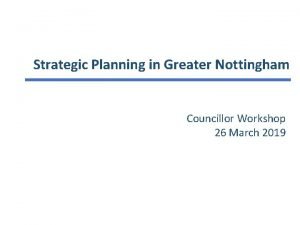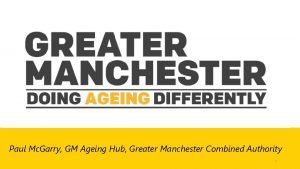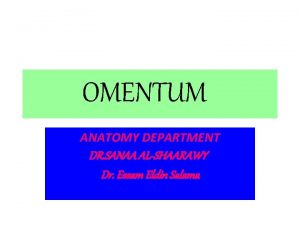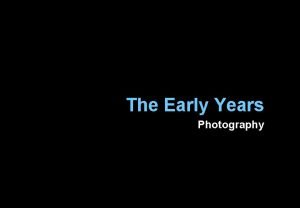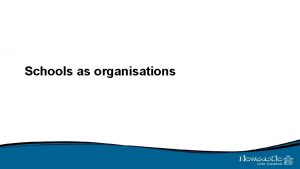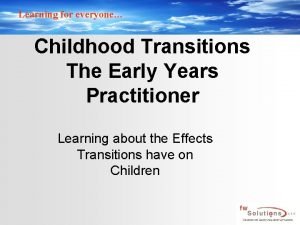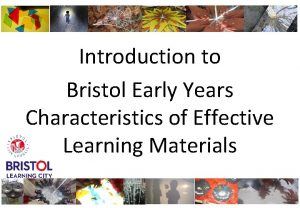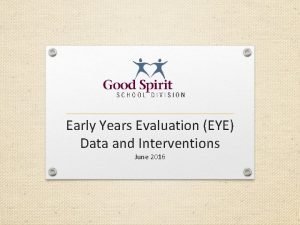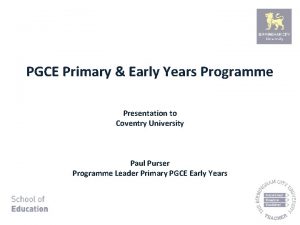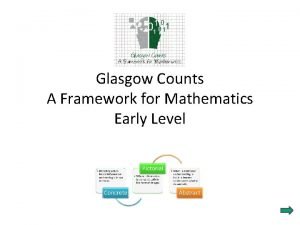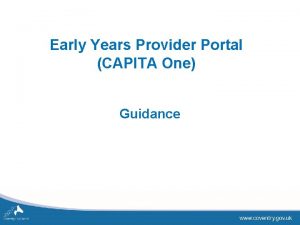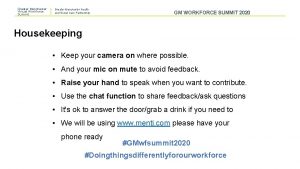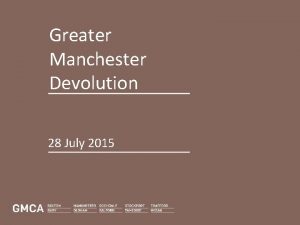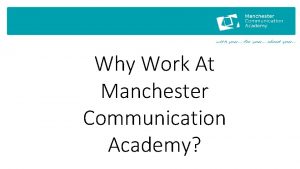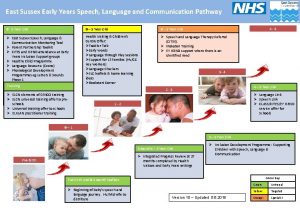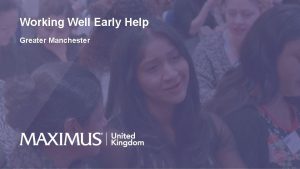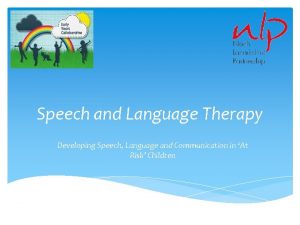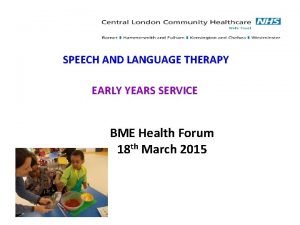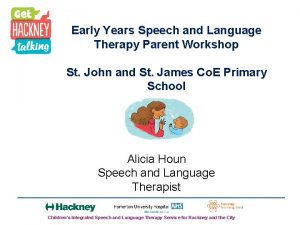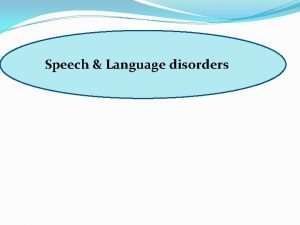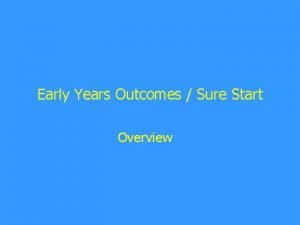Greater Manchester Early Years Speech Language and Communication























- Slides: 23

Greater Manchester Early Years Speech, Language and Communication Pathway and Specification Michelle Morris Consultant SLT Salford Royal (NHS) Foundation Trust

Greater Manchester Heath and Social Care Partnership Facts and Figures • • Covers 10 LA areas 37 NHS organisations and councils Population: 2. 8 million Budget: £ 6 billion School readiness ê than nat. av. for GLD (62. 4%) GM av. 62. 4% (range 73. 4 -57. 2%) 2 in 5 don’t reach GLD. é 1 in 2 for children on FSM |1

Devolution Manchester or as we call it Devo Manc. GM: 1 st region to receive delegated power from central government to local area • 2014: new powers transport, housing, planning and policing. • 2016 Take over the health and social care budget • Opportunity to tackle the health inequalities • GM received 450 million additional transformation funding • 2017 Election of a region Mayor today! 2

The Plan -Taking Charge 20162021 5 year plan to deliver: • 1, 300 fewer people dying from cancer • 600 fewer people dying from cardiovascular disease • 580 fewer people dying from respiratory disease • 270 more babies being é 2, 500 g making difference to long term health • Supporting people to stay well and live at home for as long as possible, with 2, 750 fewer people suffering serious falls • More children reaching a good level of social and emotional development with 3, 250 more children ready for the start of school aged 5 (other outcomes being developed) |3

GM Start Well: Early Years Strategy • The ambition: every child acquires the skills necessary to negotiate early childhood , primary and secondary education and employment. • Sets out the GM transformational vision for system change • Shift from expensive reactive public services to prevention and early intervention • Acknowledges the diverse range of stakeholders in EY system • Sets out a host of additional outcome for children • Strengthening universal and targeted services

Start Well cont … • • Break the cycle of poverty Develop a consistent approach to delivery Underpinned by integrated commissioning Strengthening family and community capacity for managing own health and well being • Recognition that cost benefits wont be realised for at least 10 years |5

Healthy Child Programme Mandated Contacts • • • Anti natal New baby review 6 -8 week assessment 1 yr. assessment 2 -2. 5 year review |6

|7

Key Features: GM 8 Stage Model • Systematic surveillance using ASQ 3. • Introduced a recommended Level 4 b assessment at 18 months. 2 years considered too late • Feedback: Very important for identifying SLCN. • ASQ 3 (Developmental) largely on parental report • ASQ (SE) Social Emotional. GM recommended for use at stages 4 - 8 • Is ASQ accurate at identifying SLCN? • Produces a risk rating White/Grey/Black • Integrate delivery: CC workers and HV team. • Increase the sensitivity of SLC assessment by introduction of Wellcomm. |8

SLCN pathway background • 2012 - developed a multi agency SLCN delivery pathway in Salford based on best available evidence and commissioned by the LA and PCT • 2014 – Asked to lead a small project group to develop a pathway based on the existing good practice. This formed the 1 st GM pathway & specification and pathway. Much of the work was already tested and had demonstrated effectiveness. Pathway developed over 2014 • 2016: Work to refresh and update the pathway & specification with wider group of stakeholders. Supported by senior GM programme manager |9


Specification • Identified required outcomes • Different levels of intervention • Communication and Language is embedded in all aspects of – Planning – Work with parents • Requirement for partnership working • Evidence based interventions for supporting families • Identifies the support required from SLT team • Workforce Development | 11

Workforce Development • Every team and setting has a Communication Lead • Level of competency for different roles • Rolling programme of training to develop universal and enhanced level competencies in SLC based on SLCF. • Recognising need for access to ongoing support and advice for staff from specialists | 12

Wellcomm • Evidence based screening tool. • Developed by Sandwell & West Birmingham NHS Hospital Trust’s SLTs service in 2010 rev. 2015 • Split into 9 stages from 6 m to 6 years • Asks 10 questions plus narrative • Direct observation, assessment and discussion with family – Eg 18 -23 m: 50% parental report – 24 -29 m: 20 % parent report | 13

Wellcomm Cont …… • Quick and easy to administer • Basic training required but can be administered by a wide range of staff. Precondition of use, universal level competencies. • Provides a profile & RAG rates children at risk • Provides clear simple intervention strategies | 14

Case study 1 Child A • Scored secure white at 26 months on ASQ • CNN had concerns used professional judgement and assessed on Wellcomm • Child screened as RED on Wellcomm • Wellcomm activities given to parents. Child referred to SALT • Assessed and advice given placed on CDW waiting list. • CDW commenced visits for individualised PCI and lang stimulation strategies. • Parents already using Wellcomm strategies & advice from SLT • Parents could see progress being made • CDW modelled further strategies which parent is now using. • Child will be reviewed in clinic following CDW visits | 15

Case study 2 child H • • • Scored grey on ASQ @ 2 yr developmental check Referred to Talking Tots (PCI group) Referrer highlighted unclear speech Child very chatty , sociable Wellcomm pre intervention: Amber with delay in expressive language. • Family and referrer surprised as so chatty • Family attended TT and received intervention in setting awaiting post intervention Wellcomm. | 16

What we know so far • Wellcomm does highlight Amber children who go on to access targeted interventions e. g. PCI, Wellcomm activities and Stay and Play • More children referred directly to SLT • Pathway is highlighting previously unmet targeted and specialist need • Example Locality W • 61 children identified on ASQ as requiring Wellcomm in 6 m period 8% Green : 70% Amber: 22% Red | 17

Key learning • Setting the standard but allowing for flexibility in local provision • The importance of developing a shared culture • Using a common language • Developing shared outcomes • The importance of enablers like info systems | 18

Next steps • Developing a communication strategy • Collecting data on improved identification with a view to a GM business case • Standardising more packages of training e. g. Wellcomm introduction • Getting rid of DNA discharge for clinical services • Rolling out the Manchester developed training for childminders | 19

Challenges • • • Encouraging consistency Data collection and sharing: different systems/rules How do we hold authorities to account? Managing preconceptions Ensuring programmes are linked e. g. Midwifery/HV specs to SLCN How do we get basic messages into communities Influencing schools as commissioners Developing analysis metrics Addressing so much unmet need | 20

Challenges to you • Upskilling the future workforce in their learning curriculum (MW, HVs, teaching staff , apprentices) • Raising level of skill required in EY settings. • Enabling inter agency data sharing • Developing a shared language we use same words with subtly different meanings • Do the Department works together? Conflicting agendas e. g. HV implementation plan increased provision ; transferred to LAs with no ring fencing. SLT: Highlighting unmet need but specialist services not sufficiently resourced to address thisd| 21

Thank You Any Questions? | 22
 Manchester and differential manchester
Manchester and differential manchester Gm health and social care partnership
Gm health and social care partnership Strategic planning workshop greater manchester
Strategic planning workshop greater manchester Greater manchester good employment charter
Greater manchester good employment charter Greater manchester ageing hub
Greater manchester ageing hub How long is four score and seven years
How long is four score and seven years Goat years to human years
Goat years to human years 300 solar years to lunar years
300 solar years to lunar years Early cpr and early defibrillation can: *
Early cpr and early defibrillation can: * Greater and lesser sac
Greater and lesser sac Shakespeare early years
Shakespeare early years Jean baptiste louis gros
Jean baptiste louis gros Summarise types of early years provision
Summarise types of early years provision Big builders medway
Big builders medway Effects of transitions in early years
Effects of transitions in early years Bristol early years characteristics of effective learning
Bristol early years characteristics of effective learning Hudson 1509 route
Hudson 1509 route Hampshire early years moodle
Hampshire early years moodle Early years learning framework overview
Early years learning framework overview Eye early years evaluation
Eye early years evaluation Characteristics of early adulthood
Characteristics of early adulthood Pgce early years
Pgce early years Glasgow counts framework
Glasgow counts framework Coventry early years portal
Coventry early years portal


